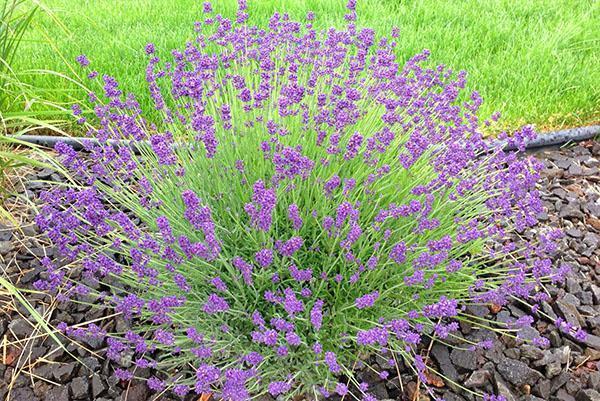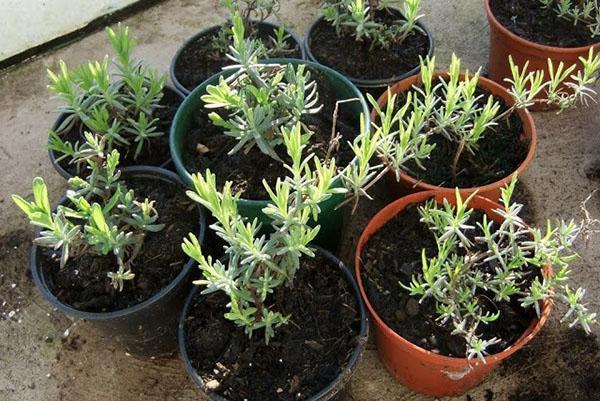Subtleties of planting and care in the open field for delicate lavender
 In the numerous family of Yasnotkovy there are a lot of plants that have amazing decorativeness, and an extraordinary aroma, and other useful properties. If the summer resident wants his site to be decorated with lavender, planting and care in the open field is a key moment on the path to success.
In the numerous family of Yasnotkovy there are a lot of plants that have amazing decorativeness, and an extraordinary aroma, and other useful properties. If the summer resident wants his site to be decorated with lavender, planting and care in the open field is a key moment on the path to success.
A perennial essential oil crop up to 60 cm high with spike-shaped blue or lilac inflorescences has become a symbol of Provence. Lavender is grown in the Mediterranean, and in Russia there are plantings in the Crimea and the Black Sea coast of the Caucasus.
Can a thermophilic plant take root in the middle lane? How to tame the culture of a gardener in Siberia or the Urals?
Among the plants related to lavender, there are many that, as a result of cultivation on personal plots, have completely assimilated, becoming part of the native flora. And some of them are well-known wild plants. It is motherwort and oregano, thyme and mint, catnip and lofant.

The timing of planting lavender in the ground

Of all the varieties of lavender, Lavandula angustifolia or narrow-leaved lavender is recognized as the most frost-resistant and unpretentious.
Under cover, it can survive frosts down to –35 ° C, which is quite comparable with winter temperatures not only in the central part of the country, but even in the Urals or Siberia.
Lavender propagates by seed and vegetatively using parts of an adult bush, rooted cuttings or cuttings.
In the first case, like many other decorative perennials:
- at home, small seeds are sown for seedlings in early spring;
- when a stable heat comes, you can sow seeds in the beds;
- planting lavender in the ground in the fall is carried out to obtain plants for next year.
Vegetative reproduction helps to bring flowering closer. In this case, seedlings with their own root system fall into the soil in the second half of summer or autumn. Specific dates directly depend on climatic and weather conditions.
In the middle lane, lavender planting in open ground and caring for it obey the rules common to all regions. The seeds should fall into the warmed-up soil when the sprouts are not threatened by spring frosts. And before that, in order to accelerate germination, they are stratified in a refrigerator.
 In the central part of Russia, such conditions for sowing develop by the second half of May. In the regions to the north and east, the soil warms up even later. Unfortunately our summer is short for lavender. Seedlings very often die without surviving the winter. Therefore, planting lavender in open ground in the Urals, for example, is preferable to seedlings obtained as a result of winter or early spring sowing, or seedlings obtained from an adult bush.
In the central part of Russia, such conditions for sowing develop by the second half of May. In the regions to the north and east, the soil warms up even later. Unfortunately our summer is short for lavender. Seedlings very often die without surviving the winter. Therefore, planting lavender in open ground in the Urals, for example, is preferable to seedlings obtained as a result of winter or early spring sowing, or seedlings obtained from an adult bush.
Planting lavender seedlings in the ground
 At the end of February or in March, when the period of stratification ends, seeds are sown on the surface of a mixture of fertile garden soil and sand. It is useful to pre-sterilize the substrate and sort out large inclusions.
At the end of February or in March, when the period of stratification ends, seeds are sown on the surface of a mixture of fertile garden soil and sand. It is useful to pre-sterilize the substrate and sort out large inclusions.
The crops are sprinkled with a thin layer of sand and placed in a home greenhouse. Germination takes place in the light at a temperature of 17–22 ° C.To maintain moisture, the soil is periodically sprayed with warm water, and to avoid the appearance of mold, the container is ventilated. The first shoots should be a signal that plants need additional backlight... When the seedlings get stronger, they are dived, seated at a distance of 5 centimeters.
It is convenient to use peat pots before planting lavender in the ground. In them, the plants develop well, their roots are protected from decay and do not suffer during transfer to the garden.
 At the end of May, it is time to plant in the ground and care for lavender in the Moscow region. For plants, choose dry, ventilated and well-lit places, where the soil has a pH level of no higher than 6.5-7.5. The site is dug up onto a bayonet, simultaneously bringing in loosening earth peat, humus and, if necessary, dolomite flour.
At the end of May, it is time to plant in the ground and care for lavender in the Moscow region. For plants, choose dry, ventilated and well-lit places, where the soil has a pH level of no higher than 6.5-7.5. The site is dug up onto a bayonet, simultaneously bringing in loosening earth peat, humus and, if necessary, dolomite flour.
 Seedlings are carefully transplanted, leaving at least 70-90 cm of free space between the plants, it will certainly come in handy for the growing bushes. During planting, the tillering point is slightly deepened, then the soil is compacted and thoroughly shed.
Seedlings are carefully transplanted, leaving at least 70-90 cm of free space between the plants, it will certainly come in handy for the growing bushes. During planting, the tillering point is slightly deepened, then the soil is compacted and thoroughly shed.
Autumn sowing of lavender is practiced only in the southern regions, where the seeds do not freeze, and immature sprouts can, without fear of spring cold, immediately grow. After planting the seeds in the ground, the beds are watered, and with the first frosts they are abundantly covered with snow.
Planting lavender in the ground with cuttings, parts of a bush and layering
 If there is an adult plant on the site, you can:
If there is an adult plant on the site, you can:
- divide it, getting seedlings with growth points and a root system;
- get cuttings that, after rooting, are easy to plant in the ground;
- create conditions for the formation of stem layering.
The lavender bush intended for dividing is carefully spud before wintering, and the shoots are cut at a height of 10 centimeters. In the spring, hilling is repeated, stimulating the formation of young shoots. A bush prepared in this way is dug up in the fall and divided into independent parts. Lavender is immediately planted in the ground, in the fall the plant has time to acclimatize and prepare for winter.
In spring and summer, lavender shoots are used for cuttings. 8-10 cm pieces of stems are planted in wet sand, deepening 2-3 cm. In a greenhouse, cuttings form roots over the summer. With further home care for lavender, planting it in open ground is carried out in May or early June.
To obtain layering, selected strong shoots in the spring are tilted to the ground and instilled in, securing them with a metal pin at a depth of several centimeters.
During the summer, the cuttings are looked after by weeding nearby soil and watering the root formation sites. In autumn, such seedlings are separated from the mother bush and planted in a permanent place in the garden.
Taking care of lavender after planting outdoors
 Lavender is planted for its fragrant blue-purple flowers. But on young plants in the first year of life, all the buds are cut off without waiting for flowering. This will strengthen the open field planting of lavender and make it easier and more effective to care for them. Throughout the life of the bushes, they must be weeded and watered.
Lavender is planted for its fragrant blue-purple flowers. But on young plants in the first year of life, all the buds are cut off without waiting for flowering. This will strengthen the open field planting of lavender and make it easier and more effective to care for them. Throughout the life of the bushes, they must be weeded and watered.
Lavender is a hardy crop, but it needs moisture to bloom. In hot weather, watering should be abundant and frequent.
Adult bushes form a dense dense cushion on the surface of the soil. Loosening the soil under them is problematic, but keeping the area around is very important. A layer of peat mulch will help to save moisture and airiness of the soil.
Spring-autumn hilling helps to maintain the crown density. It stimulates the formation of young shoots, gradually replacing aging branches. Pruning plants serves the same purpose. It is carried out after flowering and during it. For bushes aged 7 to 10 years, anti-aging pruning is recommended. During work, all shoots are shortened to 5 cm in length.
To fertilize lavender, mixtures with a predominance of potassium are used, which stimulates the formation of buds. Nitrogen applied in the spring in moderation.
Southern crops, including lavender, are at risk of freezing in Russian conditions. To prevent this from happening, the bushes before frost are covered with spruce branches, non-woven material or other breathable types of protection that allow air to pass through, and then abundantly sprinkle them with fallen snow.